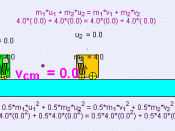1. Objective
The objective of the third experiment of the PH1004 laboratory course is broken down into two parts. In part A, the aim is to assess the conservation of momentum and of kinetic energy for an elastic collision between a moving glider, which runs along a straight line on an air track, and a stationary glider. Momentum, also linear momentum, is a fundamental quantity describing the motion of any object. It is a vector quantity, meaning that it has both amount and direction, and it is the product of the mass times linear velocity of a moving object. For an isolated system, total momentum remains unchanged over time. This conservation of momentum is one of the most important and universal of the conservation laws of physics.
An elastic collision is defined as one in which both conservation of momentum and conservation of kinetic energy are observed. This implies that there is no dissipative force acting during the collision and that all of the kinetic energy of the objects before the collision is still in the form of kinetic energy afterward.
For macroscopic objects, which come into contact in a collision, there is always some dissipation and they are never perfectly elastic.
During the investigation, the objects in the collision will be of different masses. The glider, which will be in motion, will have a larger mass than the stationary one.
In part B, the intention is to test the conservation of momentum and of kinetic energy for a perfectly inelastic collision between a moving glider, which runs along a straight line on an air track, and a stationary glider. When the colliding objects stick together after the collision, as happens when a meteorite collides with the Earth, the collision is called perfectly inelastic. In this type of collision, the...


